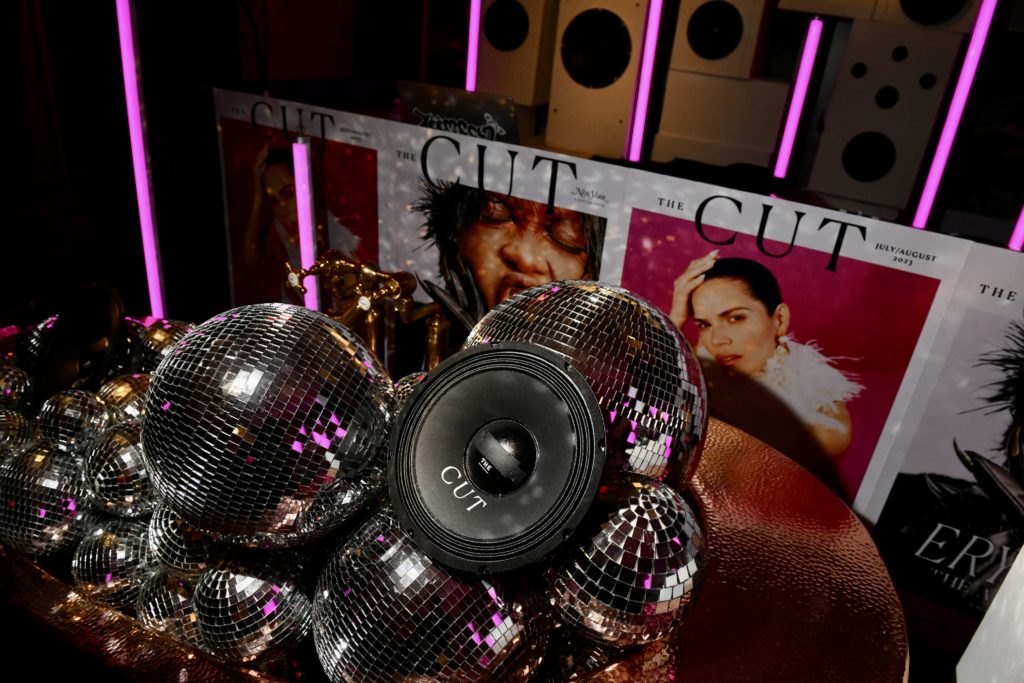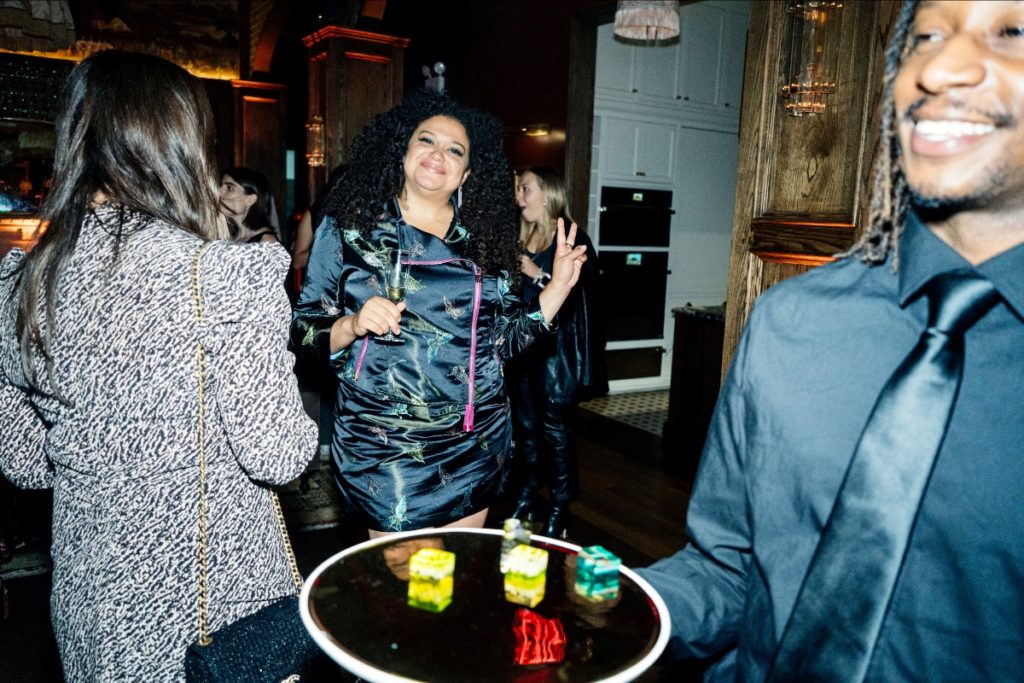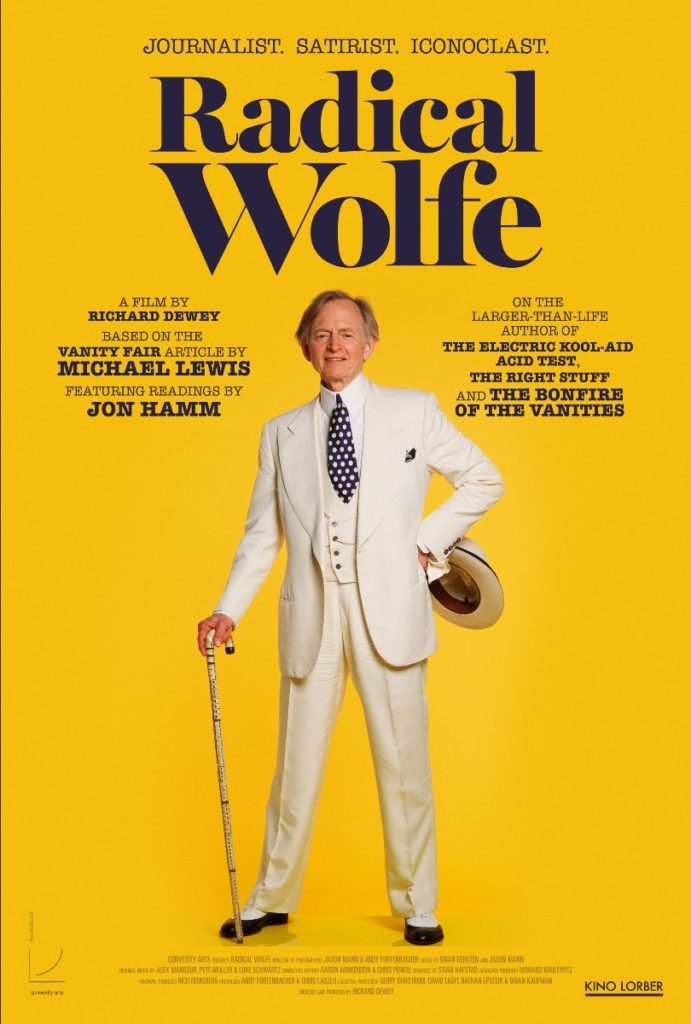Present and Past
Frenzying their way into fall: Lindsay Peoples, Max Tani, Charlotte Klein, Mark Stenberg, Angelina Chapin, Carl Swanson, David Haskell, Sonali Basak, Gay Talese, Michael Lewis, Rachel Kushner, Ethan Hawke, Christopher Beha, and many more…

Photo by Getty Images for Vox Media
If summer is about getting as far away as possible, September is about coming back and hunkering down. And in that seasonal migration, the stuff of life, bolstered with infusions of film world celebrities and publishing legends going out on the town, rushed through the media world with renewed frenzy.
OUT AND ABOUT
On Wednesday, September 13, The Cut closed out Fashion Week with a party at Maxwell Social in Tribeca. Two layers of set design hung on the space. The dominant look was a near-satire of an ancient private club, complete with doors built into bookcases and cozy reading nooks. Then, there was an overlay of explosive polyester modernity. Photo flashes rippled across the giant silver mylar wall that dominated the main room. A neon sign reading “The Cut” shimmered its light across the crumpled surface, lending a soft halo diffusion to the crowd. Editor-in-chief Lindsay Peoples’s dress matched the reflective wall. “It wouldn’t be The Cut if it was low-budget,” her make-up artist told The Fine Print. “We got to play with color today. She’s wearing a silver dress, so instead of doing silver on the eyes, I wanted to do a purple to give a little bit more of a pop of color.”

The Cut editor-in-chief Lindsay Peoples. (Photo by Poupay Jutharat)
Mini disco balls filled a bathtub in a downstairs dance hall where a remix of “In the Air Tonight” thudded through the disconcerting emptiness. “The bathtub you can’t move, so we needed to find a fun solution to make it more party adjacent,” said the event’s designer, Adrian Koenigsberg. “Filling it with disco balls is mine.” Genuine celebrities began floating through, among them the actress Rosario Dawson, comedian and actress Michelle Buteau, comedian and Netflix show host Nicole Byer, 40-weeks-pregnant DJ Vashtie Kola, and Saturday Night Live cast member Ego Nwodim.
Initially, it seemed like most of the media contingent might be media reporters. Semafor’s Max Tani was back in town after a week in Ibiza with a crew that included Futurism chief content officer Foster Kamer. “We went on a boat. It was pretty extravagant and pretty silly,” he said. What was the most expensive cover? “85 fuckin’ euros to go to a club that was terrible that Foster dragged us to, but we didn’t really know. We went to Pacha, the legendary Ibiza club that the New Yorker article was written about, and that was totally worth it.” Adweek’s Mark Stenberg had a more rustic summer, featuring an involuntarily semi-sober fishing trip in Alaska. “We brought a shit-ton of stuff to drink, but the guide cut us off early. He was like, ‘Y’all can drink two beers each,’” he said. “Still, we had liquor, and my friend, who’s a pseudo-alcoholic, was putting the liquor in our hands and being like, ‘Go to the bathroom.’ I felt like I was in high school.” Meanwhile, Vanity Fair’s Charlotte Klein had taken a trip into The Fine Print’s unlocked Slack. If her work Slack were opened to readers, she noted, “I would be in prison!”
Soon, New York staffers began to bubble up among the influencers, brand partners, and fashion designers in heavily embroidered leather and worked over denim whose names turned up nothing on Google. Features writer Brock Colyar breezed in well ahead of their profile subject, TikToker Dylan Mulvaney. “I just came from a Paris Review party. They served so much liquor, and I was like, I have to go to another party,” they said before introducing The Cut managing editor Rachel Bashein. Colyar’s editor, Carl Swanson, was in the adjoining room insisting that he was shirtless despite wearing a shirt-shaped garment that belonged to his partner Kendall Werts. Features writer Angelina Chapin asked general manager Manny Getachewabout his Fashion Week. “I was going to go to the J.Crew thing, but I went to the U.S. Open instead,” he said. “Did you get in the —” Chapin started to ask. “Oh, I didn’t go to the Rolex box,” Getachew said. “I paid.”

Comedian and actress Michelle Buteau. (Photo by Poupay Jutharat)
As Jell-O shots circled toward the end of the night, New York editor-in-chief David Haskell gamely answered a question about whether he’d considered the associations of the falling tower of children’s toy blocks on the cover of the magazine’s September 11 issue — ostensibly unrelated to any other towers that date brings to mind — before publication. “Somebody mentioned it as we were closing,” he said as Vox Media president Pam Wasserstein walked over. “I don’t see the issue. I think the world is big enough 22 years later. It’s one tower, not two.”

On Friday, September 15, director Richard Dewey premiered Radical Wolfe, his documentary about the legendary journalist and novelist Tom Wolfe, at IFC Center in Greenwich Village. A quorum of media luminaries made up the audience, among them former Time editor-in-chief and biographer Walter Isaacson, former Slate Group editor-in-chief and Pushkin Industries co-founder Jacob Weisberg, Esquire editor-in-chief Michael Sebastian, Harper’s president and publisher Rick MacArthur, Wolfe’s widow and Harper’s contributing designer Sheila Wolfe, and her and Wolfe’s daughter, former Wall Street Journal reporter Alexandra Wolfe Schiff. ESPN senior writer Tom Junod sat near the iconic Gay Talese and his daughter Catherine Talese, long ago a photography editor at Art Cooper’s GQ. The Fine Print sat next to Bloomberg Businessweek editor Joel Weber, who got up to chat with Bloomberg TV global financial correspondent Sonali Basak, who was slated to moderate the post-screening Q&A. “Are you going to the afterparty thing?” she asked. “No,” Weber said. “I’m going to go home.”
Talese conformed to his immaculately tailored reputation. As the film unspooled, he sat with an elegant hat in his lap, fingers intertwined, poker-faced. Though a giant Talese on-screen often joked, his wizened double never laughed. Radical Wolfe excavates aspects of Wolfe’s life, work, and political import that have rarely been delved into to comparable depths. Still, some of the talking heads could’ve used more of an explanation. The tech investor Peter Thiel shows up in a sequence on free speech to hypocritically proclaim, “It’s almost impossible for someone to do what Tom Wolfe did in our society today. It’s been impossible, I would say, for probably close to 40 years.” If Thiel is referring to extant obstacles to speaking truth to power, he is resolutely part of the problem. Perhaps his presence in the film has something to do with the fact that Alexandra Wolfe Schiff, who in 2017 published an enthusiastic book titled Valley of the Gods chronicling the fellowship Thiel started that gave grants to college students who dropped out and started tech companies, was three years later appointed to the board of directors of Thiel’s data-mining colossus Palantir Technologies, Inc.
In the Q&A that followed, Michael Lewis, whose Vanity Fair article on Wolfe served as the basis of the documentary, pointed out that when people get nostalgic about Tom Wolfe’s work, part of what they’re missing is money in journalism. “He goes out to research these cars. He spends four weeks in a fancy hotel, and thinks he still might not have a piece. Who pays for that now? Nobody. That’s gone. That whole economic model has collapsed,” Lewis said. “That existed in the early part of my career. I tried to bankrupt Vanity Fair with the earlier articles I wrote to them, and I couldn’t do it. There was money.”
Lewis waxed on about the cohort Wolfe dubbed the New Journalists. “Walter [Isaacson] and I went and visited Hunter Thompson in Woody Creek right before he died. He had gotten so trapped in the character he was meant to play,” he said. “We were out there late one night, and he had a fifth of vodka or tequila or something. He was just drinking it straight from the bottle. Around him in his writing room, he’d write in the kitchen, he had written out things he had said that were now Hunter Thompson aphorisms, Hunter Thompson-isms, and put them on the walls to remind himself of the character he would be in when he was writing. And that’s a bad place to be. Wolfe never got there.” Basak asked, “Given the privacy around [Wolfe], what would his family, his friends, and people who know him know that others wouldn’t?” Dewey and Lewis looked bewildered. “You’re asking us? Here they are,” Lewis said. “Do you want to take a shot at that, Sheila? Seriously, take a shot.” Someone in the audience sitting near Wolfe’s widow shouted, “She said, ‘No, thank you!’”

Photo courtesy Kino Lorber
Hearst Magazines’s personable publicists wavered on whether the afterparty Esquire hosted at Jac’s On Bond was off the record, so this reporter didn’t run a recorder. However, Esquire ran its write-up, so here’s a bit of geography: Lewis and his wife, photographer and former MTV reporter Tabitha Soren, mostly hung around the cold cuts. Disgraced former talk show host Charlie Rose (unmentioned in the Esquire write-up) hovered by the bar, blocking traffic. Junod circled up with The Americans co-stars Keri Russell and Matthew Rhys, the latter of whom this reporter initially mistook for an old Esquire writer, maybe because he plays one in 2019’s A Beautiful Day in the Neighborhood. Gay Talese, naturally, made the rounds with impressive alacrity.

On Monday, September 18, Harper’s hosted a conversation at The Center for Fiction in Fort Greene between novelist and “Easy Chair” columnist Rachel Kushner, Harper’s then-editor Christopher Beha, and actor Ethan Hawke. They were meant to answer the question posed on Harper’s September cover, “What Happened to Gen X?” At the wine reception beforehand, a Gen Xer told The Fine Print, “I want to know what happened to me, too. What the hell?” His guess? “Everybody’s parents got laid off after 20 years, so there was no hope that a normal career path was going to result in anything.” Not everybody present was so hopeless. For instance, Harper’s vice president for advertising, Jocelyn Giannini, revealed an array of unexpected powers. “I’m a minister of — I can’t remember the term — Unitarian Universalist?” she said. “I can do baptisms, marriages, or the forgiveness of sin.”
The Fine Print sat next to the target audience Harper’s offers to advertisers, some of whom passed the time while waiting for the speakers to take the stage by debating whether Barbie was woke. An audience member nearby read Swann’s Way. Media faces dotted the audience, including New York Times Magazine story editor Rachel Poser, freelance writer and Africatown author Nick Tabor, and The Drift co-editors Kiara Barrow and Rebecca Panovka. From Harper’s, we spotted deputy editor Will Stephenson, vice president for communications Giulia Melucci, senior editors Joanna Biggs and Elena Saavedra Buckley, and assistant editor Lake Micah. As the conversation got going, an intermittent buzzing came through the speaker system. “I like to have a buzzing when I speak,” Hawke said. “It reminds me of the interconnectivity of the universe.” Kushner described it as “telluric energy letting us know that God is in the room.”
The conversation itself was a touch scattered — maybe unsurprising for a bunch of Gen Xers. They never landed on an answer to the question posed by Harper’s, but the search was entertaining enough. The audience questions, unusually, introduced a necessary tension and focus. When asked what art defined her generation, Kushner named Public Enemy. The following person the microphone was passed to picked up on that thread. “I wasn’t necessarily a fan of Public Enemy, but I remember that clearly. And so for you to bring that up was great,” said Financial Times columnist Enuma Okoro, as identified by New York Timesreporter and former Harper’s intern Joe Bernstein. “But I kept thinking, if we had another person on the stage that wasn’t white, what would Gen X mean to them?”
Early in the evening, Hawke acknowledged his claim to the mantle of generational poster boy he’s maintained since early in his career. Kushner may well be the novelist who’s done the most to redeem her contemporaries. But it was Beha who made the most Gen X gesture of all when he announced his resignation later that week.
UPCOMING
Wednesday, October 11
➾ 7 p.m. John Freeman will celebrate the final installment of his annual journal Freeman’s with contributors Hannah Lillith Assadi, Kelsey Day, Colum McCann, and Chinelo Okparanta at McNally Jackson Seaport.
Thursday, October 12
➾ 6:30 p.m. Alec Ash will launch his new site China Books Review with a series of conversations at the Asia Society on the Upper East Side. Speakers include New Yorker and New York Times contributor Jianying Zha, former U.S. ambassador to China Winston Lord, Atlantic and Nation contributor Orville Schell, co-founder of The Wire China and former Times reporter David Barboza, Pulitzer-winner Ian Johnson, Guardian and Wired contributor Yangyang Cheng, and New Yorker staff writer Jiayang Fan. The event will wrap with a cocktail reception.
Sunday, October 15
➾ 5:30 p.m. Former New York Times reporter Clyde Haberman will have one of his periodic public discussions with his daughter, current Times reporter Maggie Haberman, at The Center at West Park on the Upper West Side.
Wednesday, October 18
➾ 12 p.m. The Silurians press club will host a discussion between three former New York Times sports reporters — Ira Berkow, Gerald Eskenazi, and Harvey Araton — about the demise of the sports section at The National Arts Club on Gramercy Park.
Thursday, October 19
➾ 7 p.m. Penta magazine senior editor Mitch Moxley and Bloomberg Businessweek contributor David Gauvey Herbert will host the latest edition of The Night Editor, with writer Jon Ronson, at a private loft on the border of SoHo.
Monday, October 23
➾ 7 p.m. New York Times book critic Dwight Garner will launch his new book The Upstairs Delicatessenwith a conversation with Food52 co-founder and former Times reporter Amanda Hesser in the Strand’s Rare Book Room.
Tuesday, October 24
➾ 7 p.m. Nation and Jacobin contributor Cole Stangler will discuss his new book Paris Is Not Dead with Know Your Enemy co-host Matthew Sitman at P&T Knitwear on the Lower East Side.
Thursday, October 26
➾ 6:30 p.m. New Yorker writer Charles Duhigg and Atlantic CEO Nicholas Thompson will host drinks at a bar in Williamsburg to celebrate Katie Drummond’s appointment as the editor-in-chief of Wired.
Correction: After publication, Futurism chief content officer Foster Kamer rejected Semafor media reporter Max Tani’s accusation that he had suggested going to what turned out to be a terrible nightclub during their visit to Ibiza with a group of friends. “A different friend in the group who shall go unnamed dragged us to the first club, Hï Ibiza,” he said and shared a text chain screenshot that exonerated him. The Fine Print regrets the error.
“The only club I wanted to go to was Pacha, and we did. Not that [Max] would know! Max spent half the night in the garden apparently working on his campaign for mayor of Ibiza talking to some French clubrats! I was on the dancefloor for six hours,” Kamer added. “You can also have the exclusive and announce my opposing candidacy for Mayor of Ibiza: The White Isle deserves better than Loose Facts Max.”
Asked to comment on Kamer’s allegations, Tani responded, “This is really dumb.”
